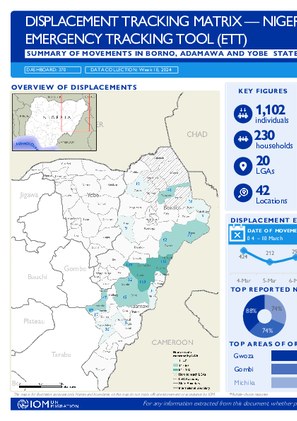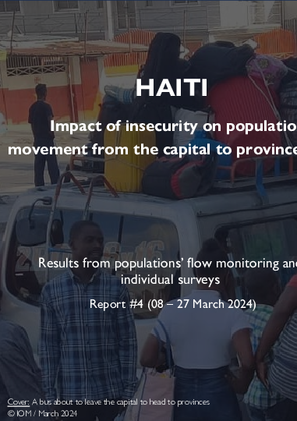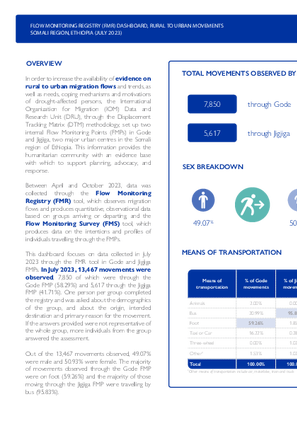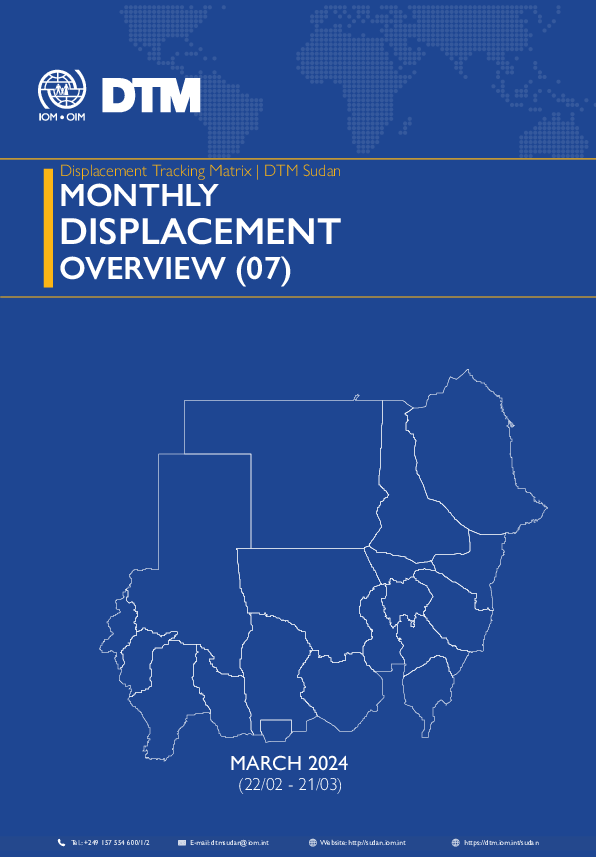-
Countries
-
Data and Analysis
-
Special Focus
-
Crisis Responses

Contact
DTM Nigeria, iomnigeriadtm@iom.int
Language
English
Location
Nigeria
Period Covered
Mar 11 2024
Mar 17 2024
Activity
- Mobility Tracking
- Event Tracking
Between 11 and 17 March 2024, a total of 1,409 new arrivals were recorded at locations in Adamawa and Borno states. The new arrivals were recorded at locations in Askira/Uba, Bama, Biu, Damboa, Dikwa Gwoza, Hawul and Monguno Local Government Areas (LGAs) of the most conflict-affected Borno State, in Fufore, Girei, Gombi, Guyuk, Hong, Lamurde, Madagali, Maiha, Michika, Mubi North, Song, Yola North and Yola South LGAs of Adamawa State.
ETT assessments identified the following movement triggers: family re-unification (435 individuals or 31%), military operation (291 individuals or 20%), poor living conditions (266 individuals or 19%), seasonal farming (173 individuals or 12%), improved security (136 individuals or 10%), fear of attack (98 individuals or 7%) and access to humanitarian support (10 individuals or 1%).

Contact
DTM Nigeria, iomnigeriadtm@iom.int
Language
English
Location
Nigeria
Period Covered
Mar 04 2024
Mar 10 2024
Activity
- Mobility Tracking
- Event Tracking
Between 04 and 10 March 2024, a total of 1,102 new arrivals were recorded at locations in Adamawa and Borno states. The new arrivals were recorded at locations in Askira/Uba, Bama, Gubio, Gwoza, Kaga, Kala Balge, Monguno and Ngala Local Government Areas (LGAs) of the most conflict-affected Borno State, in Fufore, Girei, Gombi, Guyuk, Hong, Lamurde, Madagali, Maiha, Mayo Belwa, Michika, Mubi North, Mubi South, Numan, Song, Yola North and Yola South LGAs of Adamawa State and in Geidam and Gulani LGAs of Yobe State.
ETT assessments identified the following movement triggers: poor living conditions (321 individuals or 46%), family re-unification (256 individuals or 23%), improved security (182 individuals or 17%), seasonal farming (144 individuals or 13%), military operations (77 individuals or 7%), access to humanitarian support (72 individuals or 6%) and fear of attack (50 individuals or 5%).
Contact
mtmtajikistan@iom.int
Location
Tajikistan
Activity
- Mobility Tracking
Period Covered
Sep 13 2023 -Nov 11 2023
The surveys were conducted with return migrant workers using IOM’s Mobility Tracking Matrix (MTM) system in Tajikistan. The survey locations were selected based on the results of IOM’s Baseline Mobility Assessment on returning migrant workers. The report includes findings on socio-economic profile, migration experience, employment and remittances. The survey sample was calculated based on a Baseline Assessment on the presence of returning migrant workers in the selected locations. The interviews were conducted using mobile devices and the KoBo software. All interviews were anonymous, and IOM’s Data Protection Principles were observed throughout the entire data cycle. Data collectors approached potential respondents using the snowball method to obtain their informed consent.
Population Groups
Migrants Present
Survey Methodology
Unit of Analysis Or Observation
Admin Area 2
Individual
Type of Survey or Assessment
Household
Keywords
Geographical Scope Full Coverage
Administrative boundaries with available data
The current dataset covers the following administrative boundaries

Contact
DTMUkraine@iom.int
Language
English
Location
Ukraine
Period Covered
Feb 01 2024
Feb 29 2024
Activity
- Baseline Assessment
Базова територіальна оцінка зареєстрованих ВПО надає деталізовані дані щодо чисельності та географічного розподілу офіційно зареєстрованих внутрішньо переміщених осіб (ВПО). У звіті оцінено присутність зареєстрованих ВПО на рівні громад із відображенням на мапі зафіксованих змін порівняно з попереднім раундом.
Дані, зібрані для раунду 33 Базової територіальної оцінки, відображають актуальну статистику з місцевого адміністративного реєстру ВПО станом на 29 лютого 2024 року, згідно з якою в Україні налічується 3 413 472 зареєстровані ВПО. Дані щодо кількості зареєстрованих ВПО було зібрано для 1 098 громад (83% усіх оцінених громад на підконтрольних українському уряду територіях) у 108 районах 23 областей. Дані з розподілом за віком, статтю та статусом інвалідності було надано для приблизно 83% оцінених адміністративно-територіальних одиниць.

Contact
DTM Haiti, dtmhaiti@iom.int
Language
English
Location
Haiti
Period Covered
Mar 08 2024
Mar 27 2024
Activity
- Survey
- Flow Monitoring Survey
- Flow Monitoring
In recent weeks, armed attacks have intensified in the Metropolitan Area of Port-Au-Prince (MAPAP), the capital of Haiti. In addition to creating displacement within the MAPAP, attacks and generalized insecurity are pushing more and more people to leave the capital to find refuge in provinces, taking the risks of passing through gangs-controlled routes. In order to monitor these movements towards provinces and inform appropriate response strategies, DTM has launched data collection at several of the most used bus stations in the capital (see page 5 for more details on the methodology). Since the start of this activity, on 8 March, until 27 March, this activity allowed to observe the movements of 53,125 people leaving the MAPAP (see pages 3 and 4 for more details on the profile of these people ). The majority of them (61%) took means of transport heading towards the Grand Sud departments (Grande’Anse, South, Nippes and South-East). It should be noted that this region already hosts more than 116,000 people who had in vast majority, fled the MAPAP in recent months (see the report on displacement in the Grand Sud).
It should be emphasized that provinces do not have sufficient infrastructures and host communities do not have sufficient resources that can enable them to cope with these massive displacement flows coming from the capital.
Contact
DTM Yemen, iomyemendtm@iom.int
Location
Yemen
Activity
- Mobility Tracking
- Event Tracking
Period Covered
Mar 24 2024 -Mar 30 2024
From 1 January to 30 March 2024, IOM Yemen DTM tracked 904 households (HH) (5,424 Individuals) who experienced displacement at least once.
Between 24 and 30 March 2024, IOM Yemen DTM tracked 18 households (108 individuals) displaced at least once. The majority of people moved into/within the following governorates and districts:
- Ma’rib (12 HHs) – Ma’rib City (6 HHs), Ma’rib (4 HHs), Harib (2 HHs) districts. Most displacements in the governorate originated from Ma’rib and Dhamar.
- Ta’iz (3 HHs) – Al Makha (3 HHs) district. All displacements in the governorate were internal.
- Al Hodeidah (2 HHs) – Hays (2 HHs) district. All displacements in the governorate were internal.
The majority of people moved from the following governorates and districts:
- Ta’iz (4 HHs) – Mawza (3 HHs), Ash Shamayatayn (1 HH) districts.
- Al Hodeidah (3 HHs) – Al Jarrahi (2 HHs), Al Marawiah (1 HH) districts.
- Ibb (2 HHs) – Ar Radmah (1 HH), Al Qafr (1 HH) districts.
Population Groups
Survey Methodology
Unit of Analysis Or Observation
Type of Survey or Assessment
Keywords
Geographical Scope
Administrative boundaries with available data
The current dataset covers the following administrative boundaries

Contact
DTM Yemen, iomyemendtm@iom.int
Language
English
Location
Yemen
Period Covered
Mar 24 2024
Mar 30 2024
Activity
- Mobility Tracking
- Event Tracking
IOM Yemen DTM’s Rapid Displacement Tracking (RDT) tool collects data on estimated numbers of households forced to flee on a daily basis from their locations of origin or displacement, allowing for regular reporting of new displacements in terms of estimated numbers, geography, and needs. It also tracks returnees who returned to their location of origin.
From 1 January to 30 March 2024, IOM Yemen DTM tracked 904 households (HH) (5,424 Individuals) who experienced displacement at least once.
Between 24 and 30 March 2024, IOM Yemen DTM tracked 18 households (108 individuals) displaced at least once. The majority of people moved into/within the following governorates and districts:
- Ma’rib (12 HHs) – Ma’rib City (6 HHs), Ma’rib (4 HHs), Harib (2 HHs) districts. Most displacements in the governorate originated from Ma’rib and Dhamar.
- Ta’iz (3 HHs) – Al Makha (3 HHs) district. All displacements in the governorate were internal.
- Al Hodeidah (2 HHs) – Hays (2 HHs) district. All displacements in the governorate were internal.
The majority of people moved from the following governorates and districts:
- Ta’iz (4 HHs) – Mawza (3 HHs), Ash Shamayatayn (1 HH) districts.
- Al Hodeidah (3 HHs) – Al Jarrahi (2 HHs), Al Marawiah (1 HH) districts.
- Ibb (2 HHs) – Ar Radmah (1 HH), Al Qafr (1 HH) districts.
IOM identified 7 households displaced in the previous reporting period, which covered 17 - 23 March 2024, in the governorates of Ta’iz (4 HHs), and Ma’rib (3 HHs). These figures have been added to the cumulative displacement total recorded since the beginning of the year.

Contact
DTM Ethiopia, DTMEthiopia@iom.int
Language
English
Location
Ethiopia
Period Covered
Jul 01 2023
Jul 31 2023
Activity
- Flow Monitoring
In order to increase the availability of evidence on rural to urban migration flows and trends, as well as needs, coping mechanisms and motivations of drought-affected persons, the International Organization for Migration (IOM) Data and Research Unit (DRU), through the Displacement Tracking Matrix (DTM) methodology, set up and piloted two internal Flow Monitoring Points (FMPs) in Gode and Jigjiga, two major urban centres in the Somali region of Ethiopia. The pilot ran from June 2023 through August 2023.
This dashboard focuses on data collected in July 2023 through the FMR tool in Gode and Jigjiga FMPs. In July 2023, 13,467 movements were observed, 7,850 of which were through the Gode FMP (58.29%) and 5,617 through the Jigjiga FMP (41.71%).

Contact
dtmremapsupport@iom.int mtmtajikistan@iom.int
Language
English
Location
Tajikistan
Period Covered
Sep 13 2023
Nov 11 2023
Activity
- Survey
- Baseline Assessment
The surveys were conducted with return migrant workers using IOM’s Mobility Tracking Matrix (MTM) system in Tajikistan. The survey locations were selected based on the results of IOM’s Baseline Mobility Assessment on returning migrant workers. The report includes findings on socio-economic profile, migration experience, employment and remittances. The survey sample was calculated based on a Baseline Assessment on the presence of returning migrant workers in the selected locations. The interviews were conducted using mobile devices and the KoBo software. All interviews were anonymous, and IOM’s Data Protection Principles were observed throughout the entire data cycle. Data collectors approached potential respondents using the snowball method to obtain their informed consent.

Contact
DTM Sudan, DTMSudan@iom.int
Language
English
Location
Sudan
Period Covered
Feb 22 2024
Mar 21 2024
Activity
- Mobility Tracking
- Baseline Assessment
Overview
IOM DTM Sudan presents its seventh Monthly Displacement Overview. This publication provides an account of Sudan’s displacement context since 15 April 2023 – outlining population mobility and displacement, as well the present and evolving needs of IDPs across Sudan. It provides further contextual analysis for all 18 states for the period between 22 February and 21 March 2024.
Rationale
Recognizing the need for more detailed insights into the IDP situation, including the priority needs, access to services, movement intentions, and demographic breakdowns of the affected population, DTM Sudan has undertaken a comprehensive review of our data collection tool. In collaboration with a wide range of internal and external stakeholders, we have developed a new tool to better inform humanitarian response operations, aligning with the DTM global methodology. Leveraging our extensive network of approximately 367 field-based enumerators and a robust system of over 3,362 key informants across the country, DTM gathered data on IDPs across 7,037 locations, in 181 of Sudan’s 189 localities, across all of Sudan’s 18 states, during March 2024.
Key Findings
- DTM Sudan estimates that 6,552,118 individuals (1,308,617 households) have been recently internally displaced.
- IOM DTM also reports that an estimated 2,019,027 mixed cross-border movements have been made into neighbouring countries.
- Since 15 April 2023, 46 per cent of the IDP caseload sought refuge in the Darfur and Kordofan regions, whereas 53 per cent were observed across the Northern, Eastern, and Central states.
- The majority of the IDP caseload (66%) were seeking shelter with the host community.
- While food remains the highest priority need, health and non-food items are also growing concerns.